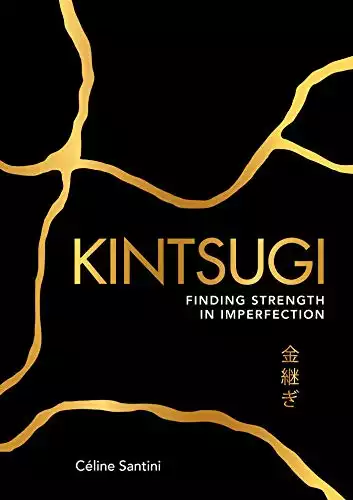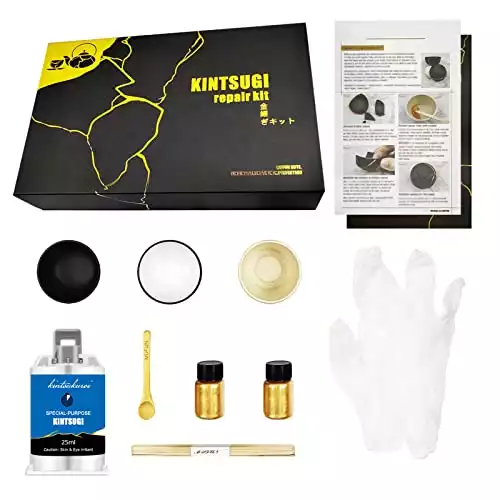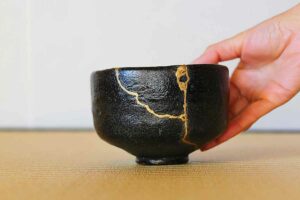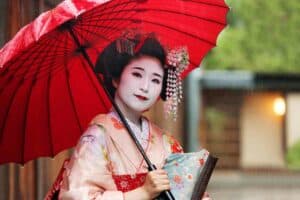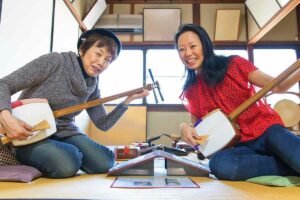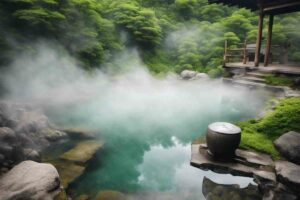Kintsugi is an ingenious Japanese craft that takes broken items, repairs them, and celebrates their brokenness by embellishing the repair with precious metals.
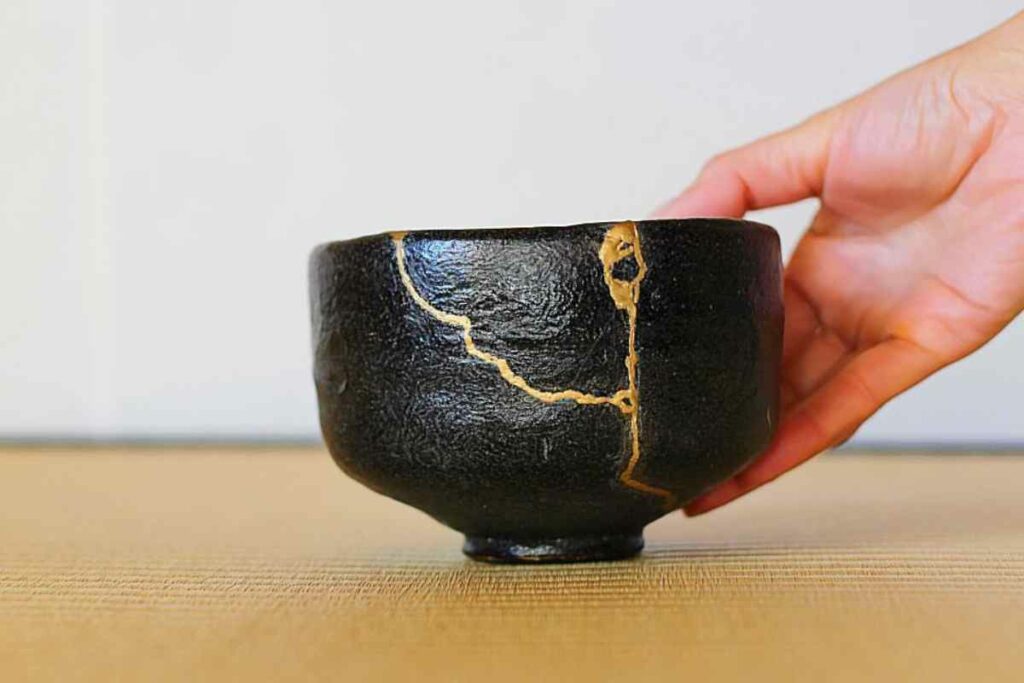
The results are not just stunning but also communicate a Japanese philosophy that understands that damage or brokenness is part of the journey.
Take a look at these exquisite kintsugi pieces and learn how you can make a kintsugi piece of your own.
‘Golden Joinery’
The Japanese word kintsugi (金継ぎ) means ‘golden joinery’.
It is a Japanese practice of repairing broken ceramics using a lacquer that is coated in powdered precious metals, usually gold or silver.
By embellishing the repair, kintsugi displays the breakage as part of the piece, rather than something to be hidden.
Learn how to embrace the adversity in your life, heal your wounds, and build a more resilient you in Céline Santini’s award-winning self-care book inspired by the ancient Japanese art of kintsugi.
A new and pleasing repair
The history of kintsugi is intertwined with the development of lacquerware and ceramics in Japan, particularly those used in the tea ceremony.
It is thought that 15th Japanese artisans created kintsugi as an aesthetically pleasing alternative to the coarse metal staple used by the Chinese for ceramic repair.
In time, wealthy Japanese collectors began to seek rarefied examples of this type of repair, even smashing pottery so it could be repaired in the kintsugi style.
Types of kintsugi
There are several types of kintsugi:
- Crack kintsugi (ひび) uses gold dust and a resin or lacquer to attach two broken pieces of pottery
- Piece method kintsugi (欠けの金継ぎ例) replaces a missing ceramic fragment with gold/lacquer
- Joint call kintsugi (呼び継ぎ) includes a similarly shaped but different piece of ceramic to replace a broken or missing piece.
Kintsugi adhesives
A kintsugi repair uses special materials that have been developed over centuries.
The adhesives used in the repair include Japanese lacquer known as urushi mixed with wheat or barley adhesive or clay. The gold powder is either pure gold, or a gold effect powder made from brass, copper, and zinc.
The repaired items are kept under high humidity for up to two weeks to ensure the repair is solid. Modern kintsugi kits use epoxy resin and other chemicals that deliver faster results.
The praise of imperfections
Kintsugi has been embraced as a philosophy of sorts because of the appreciation of flawed objects. The broken vessel cannot return to what it was but must be accepted as it is.
Rather than discarding a damaged item, it is made into something new. The golden detailing outlines the change and impermanence of the item.
In many ways it is a demonstration of wabi-sabi (侘寂), learning to accept imperfections. It also relates to the Japanese philosophy of mushin (無心) or ‘no-mind’ which is accepting change.
Kintsugi as an artform
Kintsugi is used in Japanese art and has also been adopted by foreign artists and ceramists.
In the 19th century, Western art collectors were fascinated by kintsugi when they first saw it, because of the tendency to discard broken items.
Kintsugi is now widely used in modern art, because of its symbolism and ability to pull together different materials for a beautiful result.
Learning kintsugi
The Japanese are rediscovering many of their traditional crafts and kintsugi is increasing in popularity across Japan as people experiment with the existing techniques.
The kintsugi technique is extremely versatile and can be applied to a wide range of projects.
Kintsugi is also used as a therapy, because it is creative and contemplative and helps people consider and cope with their own weaknesses and flaws.
Taking care of kintsugi items
Good quality kintsugi items are usually usable and have a long lifespan. However, if you want to use and clean a kintsugi item it must be washed by hand.
The natural materials in authentic kintsugi won’t survive a dishwasher and should never be placed in a microwave, because of the potential for the metal in the repair to spark!
Try kintsugi for yourself with a kintsugi repair kit
If you have some neglected broken ceramics that are gathering dust in your attic, you can create your own work of art with a Japanese kintsugi repair.
You can purchase a kintsugi repair kit that includes the adhesives and mica gold necessary for an exquisite DIY repair.
If you intend to use the repaired item for food and drink, be sure to purchase a kit with food-grade adhesives as some of the resins used are quite nasty.
Here’s my recommended kintsugi kit.
Repair Your Meaningful Pottery with Gold Powder Glue – Comes with Two Practice Ceramic Cups for Starter
Kintsugi Facts
What is Kintsugi?
Kintsugi is a Japanese art form that involves repairing broken pottery with gold or silver lacquer.
What does Kintsugi mean?
Kintsugi means “golden joinery” in Japanese.
When did Kintsugi originate?
Kintsugi is believed to have originated in the 15th century in Japan.
What is the philosophy behind Kintsugi?
Kintsugi is based on the philosophy of wabi-sabi, which emphasizes the beauty of imperfection and impermanence.
What materials are used in Kintsugi?
Kintsugi typically uses a urushi lacquer made from the sap of the Japanese lacquer tree, along with gold or silver powder.
How is Kintsugi done?
Kintsugi involves carefully fitting broken pieces of pottery back together using the lacquer and gold or silver powder.
What are the benefits of Kintsugi?
Kintsugi not only repairs broken pottery, but also adds value by highlighting the beauty of the imperfections.
Is Kintsugi only used for pottery?
Kintsugi can also be used to repair other items, such as glass, wood, and even clothing.
Is Kintsugi still popular today?
Yes, Kintsugi is still popular today, both in Japan and around the world.
What is the significance of using gold or silver in Kintsugi?
Gold or silver is used in Kintsugi because it represents the idea of transformation and the beauty that can be found in imperfection.
Who is the best Kintsugi Maker?
Some well-known Kintsugi artists include Yoko Sekino-Bove, Takayuki Hara, and Toshiaki Yoshida. However, the beauty of Kintsugi lies in the uniqueness and individuality of each piece, as each repair is done by hand and is therefore one-of-a-kind.
Rounding Up
Kintsugi adds character to just about any item it is used on. After all, no two pieces of kintsugi ceramic or lacquerware are the same.
So the next time you smash a plate or break a teapot, you know you’re in for a gold-plated upgrade!
- Japanese Wedding Traditions (Venue, Dress & Food)
- Kintsugi: Perfectly Imperfect Ceramic Art (with 8 Examples)
- 5 Best Japanese Makeup Brushes for a Flawless Finish
- Maiko Vs Geisha Compared: What Are the Differences?
- Japanese String Instruments (9 Famous Ones)
- Best Onsen Destinations In Japan (10 Top Locations)

